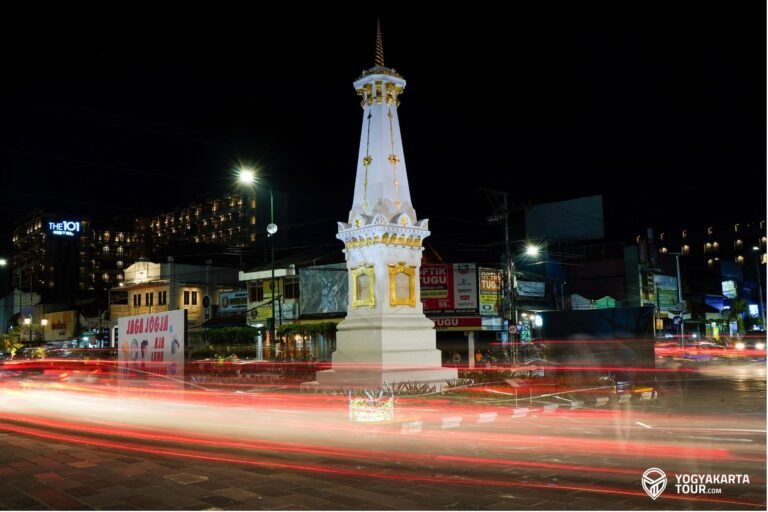The Borobudur Temple is situated in Magelang Regency, Central Java, and is renowned as the largest Buddhist temple in the world, attracting both local and international tourists. It covers an area of approximately 2500 square meters and has a length of 121.66 meters, a width of 121.38 meters, and a height of 35.40 meters, making it a magnificent and beautiful temple to behold.
The temple was built around the 9th century AD during the reign of the Syailendra dynasty by followers of Mahayana Buddhism. It is decorated with numerous stupas and was created as a representation of the universe, serving as a sacred place to honor Buddha and also as a pilgrimage site to guide people in transitioning from worldly desires to enlightenment and wisdom, following the teachings of Buddha.
It’s no surprise that Borobudur Temple is now included in the list of the Seven Wonders of the World, given its cultural and historical significance and its sheer grandeur.
The journey from Yogyakarta International Airport to Borobudur Temple is approximately 61.2 kilometers, and it is estimated to take around 1 hour and 26 minutes by car.
The route generally involves traveling through well-maintained roads, offering scenic views of the Indonesian landscape.
How to Travel From Yogyakarta Airport to Borobudur Temple by Train, Online Taxi, Damri, and Motorbike
Travelers have multiple options when traveling from Yogyakarta International Airport to Borobudur Temple. Each option has its own time and cost considerations.
The nearest route to Borobudur is via Dekso, Nanggulan to Kalibawang. Balkondes Bigaran is the closest village to Yogyakarta International Airport (YIA) in the Borobudur sub-district. This village is approximately a one-hour drive by car.
Alternatively, you can use Damri, which serves as a transportation mode that supports passengers arriving or departing from Yogyakarta International Airport (YIA).
| Mode of Transport | Estimated Time | Cost | Additional Notes |
|---|---|---|---|
| Online car | 1hr 26min | IDR 200k – 300k | Quick and convenient with estimated time and cost range |
| Damri Bus | 2 hours | IDR 75k | Economical choice with a longer travel time |
| Train | 15 minutes to Wojo Station | IDR 10k | Fast and cost-effective for solo travelers |
| Online motorbike | 1hr 26 min | IDR 150k – 200k | Suitable for solo travelers with specific budget considerations |
source: Kompas.com
Note: All costs are approximate and may vary based on specific circumstances and travel conditions.
What Is the Cheapest Way to Get From Yogyakarta Airport to Borobudur Temple?
The train is an attractive choice for individual travelers seeking the most cost-effective option. Offering a swift and efficient commute, the train journey from Yogyakarta International Airport to Wojo Station is completed in just 15 minutes.
Remarkably, this convenience comes at a highly economical cost, with the fare amounting to a mere IDR 10k.
Opting for the train not only ensures a budget-friendly travel experience for solo adventurers but also provides a quick and time-efficient mode of transportation to Wojo Station, offering a seamless connection to the journey towards Borobudur Temple.
What Is the Fastest Way to Get From Yogyakarta Airport to Borobudur Temple?
The fastest way to travel from Yogyakarta International Airport to Borobudur Temple is typically by using an online car service or a private taxi.
These options provide a direct and efficient route, minimizing travel time and ensuring a swift journey. The estimated time for this mode of transportation is approximately 1 hour and 26 minutes.
Additionally, online car services offer the convenience of door-to-door transportation, allowing passengers to reach their destination without the need for multiple transfers or stops.
While the cost may be higher compared to other modes of transport, the speed and directness make it the fastest choice for those prioritizing a quick and seamless journey from Yogyakarta International Airport to Borobudur Temple.
Tips for optimizing travel time and efficiency
Optimizing travel time and efficiency is key to a smoother and more enjoyable journey. Here are some valuable tips to help you make the most of your travel:
1. Make User of GPS
GPS and mapping software have revolutionized route planning. These tools, like Google Maps, offer detailed mapping data and turn-by-turn directions for improved trip experiences.
Google Maps, known for its user-friendly interface, provides real-time traffic updates and alternative routes based on current road conditions, enhancing efficiency.
Specialized route planning software caters to organizations and professionals with additional capabilities, allowing for complete route optimization.
These programs consider factors like traffic patterns and vehicle constraints, significantly boosting efficiency and cost-effectiveness, especially for firms relying on transportation and logistics.
2. Think About Traffic Patterns and Peak Hours
Efficient route planning requires consideration of traffic patterns and peak hours. Familiarize yourself with local traffic conditions by observing major roads and intersections at different times of the day.
Utilize real-time traffic information from apps like Google Maps and Waze to stay informed about congestion, accidents, and road incidents.
Plan your journeys by avoiding peak hours when traffic is at its worst, typically during rush hour or events like school dismissals.
Explore less congested alternative routes during peak hours, as suggested by GPS and mapping software. These routes may be longer but can save time by avoiding heavy traffic areas.
3. Adjust for Distance and Time
Efficient trip planning involves optimizing routes for both distance and time.
Algorithms or specialized route planning software consider factors like road distance, projected trip time, traffic patterns, and speed limits to find the most effective routes with real-time adjustments.
This minimizes both distance and travel time, reducing fuel usage and increasing environmental sustainability.
Selecting routes that minimize trip time is crucial for resource optimization and productivity. Consideration of variables like road conditions and closures ensures realistic and current route planning.
4. Make Provisions for Multiple Stops and Sequential Ordering
Efficient route planning is crucial when making multiple stops, saving travel time and distance. Gather relevant information about each stop, including addresses, special requirements, and delivery time windows.
Organize stops to reduce backtracking and streamline the route, considering proximity and time constraints.
Be aware of potential bottlenecks or traffic patterns, using real-time data to adapt your route if needed.
Consider your vehicle’s capacity and any special needs related to the stops for efficient resource usage. Planning your itinerary based on these considerations ensures a successful and streamlined journey.
5. Update and Adapt Routes Regularly
Regularly updating routes is crucial for travel efficiency. Stay informed with real-time data, particularly traffic information from GPS apps.
Check for congested areas, accidents, and road closures to proactively alter routes and ensure smoother travel.
Be aware of other factors like road closures or construction by checking local authorities’ notifications. Utilize real-time modification options in GPS programs for dynamic route changes and adaptability.
Flexibility is key for unforeseen circumstances, allowing you to meet customer requirements and efficiently use time and resources.
Yogyakarta Airport: Things Travelers Need to Know!
So are you coming to Yogyakarta soon? Are you wondering what Yogyakarta Airport looks like?
Do you want to know how to get to Jogjakarta city center (from Yogyakarta International Airport) without having to worry about scams? Some of these things and more might crossed your mind. Worry not my friend.
The old airport: Adisucipto International Airport (JOG)—no longer accepting commercial flights (except Wings Air to several cities such as Bandung, Surabaya, and Lombok) and the new airport: Yogyakarta International Airport (YIA) is one of the friendliest airports you’ll ever visit in Indonesia.
1. YIA as New Airport!
The AITA code for Yogyakarta International Airport is YIA (the old airport Adisucipto International Airport AITA code is JOG).
The old Jogja airport/JOG is conveniently situated close to the city center, in the eastern part of the town and approximately 6 km away from the city center.
However, Yogyakarta International Airport/YIA is situated far from the city center, around 45 km southwest in Kulon Progo. The drive from Yogya’s new airport in Kulon Progo to the city center takes 1.5-2 hours.
2. Best Transfer Airports
The Yogyakarta airport stands out as one of the best transfer airports the individual has experienced in Indonesia. Remarkably, there is no hassle at all.
Despite encountering middle-aged individuals offering airport transfer services, they are, for the most part, exceptionally polite.
There is no pushing, nagging, or hassle involved. If you decline their services by saying “no,” they readily understand.
3. ATM Machine Everywhere
ATM machines are available at the airport, with at least 3 or 4 located close to the conveyor belts. Additionally, money changers are present; however, it is not recommended to use them as the exchange rate is typically not favorable.
4. Vehicle Option
Yogyakarta International Airport (YIA) offers various transportation options to reach the city center.
The choices include arranging a private car rental for pickup at the airport, taking the train from Yogya airport to the city center, opting for the Damri bus with multiple available routes, using SatelQu (with a counter at the airport), or getting a taxi from the designated taxi counter.
5. Busiest Airport in Java
Ranked as the third busiest airport in Java, Yogyakarta Airport follows Soekarno–Hatta International Airport (CGK) in Jakarta and Juanda International Airport (SUB) in Surabaya.
This heightened activity is a result of Yogyakarta’s status as one of the most frequently visited cities in Indonesia.
Ticket Entrance Borobudur Temple
In a day, visits to the largest Buddhist temple in the world are subject to a quota system, allowing 150 people per hour or a total of 1,200 people per day.
According to the @borobudurpark Instagram account, domestic tourists wishing to enter the Borobudur Temple area must purchase tickets priced at Rp120,000 for adults and Rp75,000 for children under 10 years old.
However, for foreign tourists, the ticket prices are higher.
For a more detailed breakdown, the following are the entrance ticket prices for Borobudur Temple, distinguishing between the Temple Structure area and the Temple Ground area.
Temple Ground Ticket
This ticket grants access to the courtyard of the temple but does not include entry to the temple’s structural area.
- Tickets for Domestic Tourist
Adults >10 : Rp50,000
Child 3 – 10 : Rp25,000
- Tickets for Foreign Tourist
Adults >10 : Rp375,000
Child 3 – 10 : Rp225,000
Temple Structure Ticket:
Ticket special tickets allow you to ascend the temple, inclusive of access to the temple grounds. With this ticket, you will receive a guided tour narrating the history of Borobudur Temple and a special pair of sandals, Upanat.
- Tickets for Domestic Tourist
Adults >10 : Rp120,000
Child 3 – 10 : Rp75,000
- Tickets for Foreign Tourist
Adults >10 : Rp455,000
Child 3 – 10 : Rp305,000
Source: ticket.borobudurpark.com
FAQ: Traveling from Yogyakarta to Borobudur
- What is the distance from Yogyakarta to Borobudur?
The distance between Yogyakarta city center and Borobudur Temple is approximately 42 kilometers (26 miles). The travel time is around 1–1.5 hours by car or bus, depending on traffic. - How can I get to Borobudur from Yogyakarta?
- By Car/Taxi: You can hire a private car or taxi for a direct and comfortable journey.
- By Bus: DAMRI buses operate from Yogyakarta International Airport (YIA) to Borobudur. You can also take a bus from Jombor Bus Terminal in Yogyakarta to Borobudur.
- By Tour Packages: Many travel agencies offer day tours from Yogyakarta to Borobudur.
- By Motorbike: Renting a motorbike is another affordable and flexible option.
- Are there DAMRI buses from Yogyakarta to Borobudur?
Yes, DAMRI buses provide transportation from Yogyakarta International Airport (YIA) to Borobudur. The journey typically takes about 1.5 hours. - What is the nearest airport to Borobudur?
The nearest major airport to Borobudur is Yogyakarta International Airport (YIA), located approximately 55 kilometers (34 miles) away. Another option is Adisutjipto Airport, which mainly serves domestic flights and is around 45 kilometers (28 miles) from Borobudur. - Is there an airport at Borobudur?
No, Borobudur does not have its own airport. The closest airports are in Yogyakarta: Yogyakarta International Airport (YIA) and Adisutjipto Airport. - What is the best way to travel from Yogyakarta to Borobudur Temple?
The best way depends on your budget and preferences:- Convenience: Hire a private car or taxi.
- Budget: Take a bus or join a group tour.
- Adventure: Rent a motorbike and enjoy the scenic route.
- Can I visit Borobudur directly from the airport?
Yes, DAMRI buses and private taxi services are available from Yogyakarta International Airport (YIA) to Borobudur. - How far is Borobudur from Yogyakarta Airport?
From Yogyakarta International Airport (YIA), Borobudur is about 55 kilometers (34 miles). From Adisutjipto Airport, the distance is approximately 45 kilometers (28 miles).
If you need more information or assistance planning your trip, feel free to ask!
Embark on an unforgettable journey to Java, Indonesia, where a world of wonders awaits! Java, the heart and soul of Indonesia, is a treasure trove of diverse landscapes, rich cultural heritage, and breathtaking experiences.
Find out the package now from Yogyakarta Tours
- 1 Day Tour:
- Multidays Tours

![Navigating to Borobudur Temple from Yogyakarta Airport [Transport Guide] 1 - Goajomblang.com Yogyakarta Airport to Borobudur Temple](https://yogyakartatour.com/wp-content/uploads/2024/01/alain-bonnardeaux-f7ijLWwM9fg-unsplash-1.jpg)




